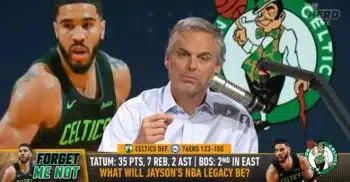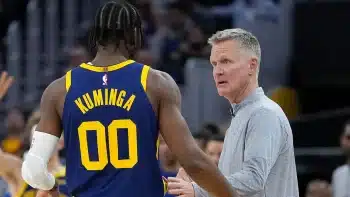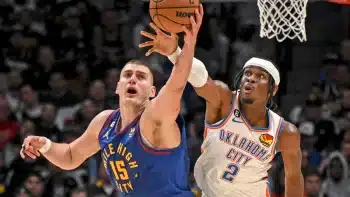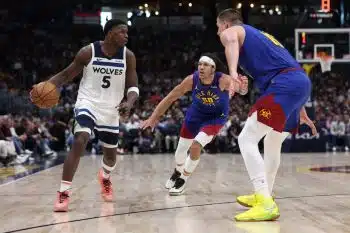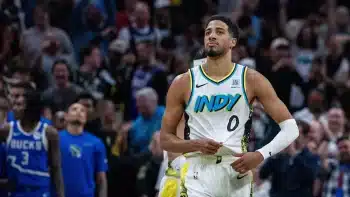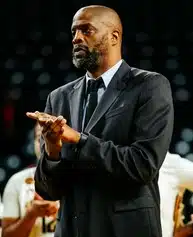NBA
NBA PM: Executives’ Biggest Draft Mistakes
Every GM and team president doing research right now on which players to select in the draft later this month will eventually make selections that they believe, with all their hearts, are the right ones.
Of course, history has shown us that the overwhelming majority of those selections will be bad and that there’s no tried and true formula that determines which guys will be superstars and which will be huge duds. If there were, the best players would always go first, and there would be little need for a second half of the first round, let alone any sort of second round.
Some strategies, however, have often proved less successful than others, so today we look at some of the biggest mistakes that executives make at the draft:
#5 – Drafting Players with Questionable Character
Why They Do It: Because Dennis Rodman and Allen Iverson existed. Of course, dealing with Iverson’s occasionally bad attitude or Rodman’s off-the-court circus was manageable when their teams were making the NBA Finals in large part because of them, but sometimes elite talents can play well enough for a team to depend on them, then blow up at the worst possible time (see Artest, Ron). Even Artest’s early-career headaches were preferable to some players who couldn’t even behave themselves long enough to make an impact on the league. Using a first-round pick on a troubled player is a tremendous risk, but GMs often do it anyway because lottery-quality talents tumble on draft day for these personal reasons, and at some point a team can’t help but think, “Well, they’ve slipped this far…”
Unless they slip to the second round, however, there are often safer players worthy of those guaranteed first-round contracts. Either the talent is so transcendent that they’re a lottery pick no matter what, or they can wait until later in round 2.
Case In Point: Terrence Williams (New Jersey, 11th pick, 2009), Sean Williams (New Jersey, 17th pick, 2007), Sebastian Telfair (Portland, 13th pick, 2004), Keon Clark (Orlando Magic, 13th pick, 1998).
This Draft’s Potential Culprit: The Texas Legends’ P.J. Hairston was booted out of the University of North Carolina before his junior season got underway because of some questionable activities and questionable associations discovered by the university. The legal case against him was eventually dropped and he seems to have moved on, but he is the most noteworthy first-round candidate with any sort of serious legal issues in recent years.
#4 – Drafting Players with Injury Histories
Why They Do It: Because injuries heal, but talent lasts forever. At least, that’s what teams tell themselves when they go ahead and commit to someone that has a history of injuries. Every year, someone drops further and further down the board because of some mystery ailment that caused a red flag during the workout process, and every year there’s a team that uses a first-round pick on that guy anyway. Sometimes, things pan out okay, like with Jared Sullinger in Boston and Kyrie Irving in Cleveland, but drafting an injured player, or a player who has only recently recovered from a serious injury, can be incredibly risky.
Case In Point: Anthony Bennett (Cleveland, 1st pick, 2013), Greg Oden (Portland, 1st Pick, 2007), Brandon Roy (Minnesota, 6th pick, 2006).
This Draft’s Potential Culprit: Joel Embiid is a potentially franchise-altering center with plenty of room to grow and game-changing skills on both sides of the floor. Unfortunately, he’s coming off a back injury that kept him from finishing out the full season at Kansas, and asking his body to take on the wear and tear of an 82-game NBA season (plus the playoffs, potentially) could be too much. He’s the best center prospect in years, but is he worth the top overall pick if there are equally talented players available without all the wear and tear at age 19?
#3 – Drafting for Potential
Why They Do It: Because open air is much more beautiful than a closed ceiling. How many times have tried and tested college players been passed over for younger guys that have barely even seen the floor for their college teams? The problem with four-year college seniors, though, is that by age 22 teams have a really good sense of who those players are going to be, while others, at age 19, have so much more ahead of them to look forward to. Athleticism seems to be the motivating force here in most instances, plus relative youth could mean more years of NBA service.
Think of it this way: if you were guaranteed $10 right now or a scratch-off lottery ticket that would leave you with either $50 or nothing, which way would you go? The potential reward is so high for some of these kids that executives can’t help but look right past the more established players with the better resumes.
Case In Point: Brandon Knight (Detroit, 8th pick, 2011) over Kemba Walker and Klay Thompson; Marvin Williams (Atlanta, 2nd pick, 2005) over Chris Paul and Deron Williams; Shaun Livingston (4th pick, L.A. Clipperes, 2004) over Luol Deng and Andre Iguodala; Kwame Brown (Washington, 1st pick, 2001) and Eddy Curry (Chicago, 4th pick, 2001) over Jason Richardson, Shane Battier, Joe Johnson and Richard Jefferson; Jonathan Bender (Toronto, 5th Pick, 1999) over Richard Hamilton, Andre Miller, Shawn Marion and Jason Terry.
This Draft’s Potential Culprit: Zach LaVine is an athletic freak who was nowhere near the best player on his UCLA team this past season, but his stock continues to improve throughout the workout process because, essentially, he can jump really high. There is more to his game than that, but the reason teams are drooling over him more than UCLA teammates Kyle Anderson and Jordan Adams, both of whom were more important to the team last year, is because of LaVine’s measurements and physical attributes.
#2 – Drafting International Players
Why They Do It: Because dominant players do exist overseas; you just have to find them. Drafting international talent is only recently recovering from a pretty poor stretch in which very few new international stars were mined from the draft’s first round. There have been plenty of huge international success stories, though, with Dirk Nowitzki, Tony Parker and others having made All-Star and All-NBA teams, but there have been a lot of international disasters in the first round, as well. It’s perfectly appropriate to try and find international gold in the lottery, but more often the league’s most successful overseas players are either late first-rounders, second-rounders or flat-out free agency signings. To find one in the lottery is rare, which is why GMs may be smarter to take their risks on players overseas with later selections.
Case In Point: Rucky Rubio (Minnesota, 5th pick, 2009), Yi Jianlinan (Milwaukee, 6th pick, 2007), Fran Vasquez (Orlando, 11th pick, 2005), Darko Milicic (Detroit, 2nd pick, 2003), Nikoloz Tskitishvili (Denver, 5th pick, 2002), Frederick Weis (New York, 15th pick, 1999).
This Draft’s Potential Culprit: Dante Exum is a 6’6”, supremely-gifted point guard with a great attitude and a pristine track record as a coachable kid, but there’s very little benchmark for how he’ll handle NBA talent. An even bigger question mark, though, might be Jusuf Nurkic, a 6’11” Bosnian center that has international scouts fawning, despite the fact that he never topped 17 minutes a game in either Adriatic League or Eurocup action last season, most often due to foul trouble. He’s a big boy with a great offensive skill set, but he’s also a huge gamble, especially considering he’s slotted to go somewhere toward the back of the lottery.
#1 – Drafting Size
Why They Do It: Because you can’t teach height. The best seven-footers to have graced NBA courts have been unstoppable, so when somebody comes around with size it’s hard to ignore the fact that they may end up being equally unstoppable. The truth, though, is that unless you’re finding someone in the top few picks, these seven-footers more often serve as six fouls to give rather than a real, contributing member of an NBA team. Even then, drafting seven-footers is no sure thing. Most are stiffs, plain and simple, and it’s very hard to find a behemoth outside of the lottery who actually formulates himself into a perennial All-Star player. It just isn’t very common.
Case In Point: Hasheem Thabeet (Memphis, 2nd pick, 2009), Patrick O’Bryant (Golden State, 9th pick, 2006), Mouhammed Saer Sene (Seattle, 10th pick, 2006), Pavel Podkolzin (Utah, 21st pick, 2004), Sagana Diop (Cleveland, 8th pick, 2001), Michael Olowokandi (LA Clippers, 1st pick, 1998), Shawn Bradley (Philadelphia, 2nd pick, 1993).
This Draft’s Potential Culprit: Most of this year’s tallest potential first-rounders are all international prospects, which sort of makes them a double whammy for GMs looking to draft them. Nurkic (6’11”) is one, obviously, but Kristaps Porzingis (7’0”) of Latvia and Clint Capela (6’11”) of Switzerland are worth mentioning, too, even though aren’t the typical seven-foot stiffs. Both come in at around 220 lbs, making it hard to believe they’d last long at center in the NBA without putting on some weight or playing more of an inside-out game. Walter Tavares (7’3”) is a likely second-round pick with huge size, but again, that late in the draft it’s hard to believe he’d be much of a difference-maker, at least not at an All-Star level.
Honorable Mention:
Drafting Undersized Players
Why They Do It: Because these guys can score! When it comes to drafting 5’11” point guards, 6’2” shooting guards or 6’7” power forwards, there’s no doubt that some risk is involved, but the accomplishments of Isaiah Thomas in Sacramento has shown recently that, sometimes, small guys really can succeed in the NBA. Allen Iverson, Spud Webb and Muggsy Bogues did it before him, and at the power forward position, Charles Barkley, Dennis Rodman and even Carlos Boozer have seen their fair share of NBA dominance despite being undersized. There are guys who make it in this league despite their height, but it’s much more common that they can’t cut it at their more natural position because they’re too small.
Case In Point: Johny Flynn (5’11, 6th pick, 2009), Ike Diogu (6’8”, 9th pick, 2005), Sean May (6’8”, 13th pick, 2005), Mike Sweetney (6’8”, 9th pick, 2003), Speedy Claxton (5’11”, 20th pick, 200 draft).
This Draft’s Potential Culprit: Shabazz Napier (6’1”) was the NCAA tournament’s big star last year, but the reality is that he’s a shooting guard in a point guard’s body. He may be a late first-round pick, but it’s not going to be easy for him to continue his scoring success without the handle and court vision of a more traditional point guard. Louisville’s Russ Smith (6’1”) may have similar problems, but he’s appropriately slated to be drafted somewhere in the mid-second round, where a pick like that carries significantly less risk.
Drafting for Need over Best Player Available
Why They Do It: Because we already have Tayshaun Prince at small forward, thank you very much, but really need a power forward. Hence, Darko Milicic must be the right pick for us, not the clearly more gifted player in Carmelo Anthony.
It still is hard to believe that actually happened, but this sort of thing happens all the time. Teams really need a point guard, but all the good point guards have already been snatched up, leaving a pool of third rate point guards and some top-shelf players at other positions for which the team currently has no apparent need. Strong assets, regardless of position, are what are important for building a successful roster in this league, and teams like Detroit can figure out how to trade Anthony or Prince a heck of a lot easier than cans swallow the bitter failure of someone like Milicic.
Case In Point: Sam Bowie (Portland, 2nd pick, 1984) over Michael Jordan, Darko Milicic (Detroit, 2nd pick, 2004) over Carmelo Anthony.
This Draft’s Potential Culprit: It’s hard to say which teams will employ this method, but Utah, at pick #5, is in an interesting position to do something crazy. The best player available for them there is likely to be either Marcus Smart, Julius Randle or Noah Vonleh, none of whom they really need, but their desire to shore up the center position may have them draft Nurkic sooner than expected.
It’s easy to pick apart all these selections in retrospect, but anyone who has followed the draft long enough knows that these things have all happened enough to be considered troublesome trends.
So if an executive can’t do any of this stuff, what can they do? The best way to look at it is to weigh the risk vs. the reward, or the player against the rest of the remaining field. It’s a delicate art, but if there are equally talented (or nearly equally talented) players available at the same draft position as someone who exhibits one of these risks, why make the gamble? If that player is far and away the best player left and there’s no way he should have ever slipped that far, then maybe grabbing him with a late first-round pick is worth the guaranteed money. More often than not, though, there are better options out there.
Good GMs have to take risks sometimes, and the draft is one place where those risks are riskiest, but to gamble just for the thrill of it is silly. Sometimes, high-character, experienced kids with just enough talent, just enough drive and just enough leadership really are enough.
